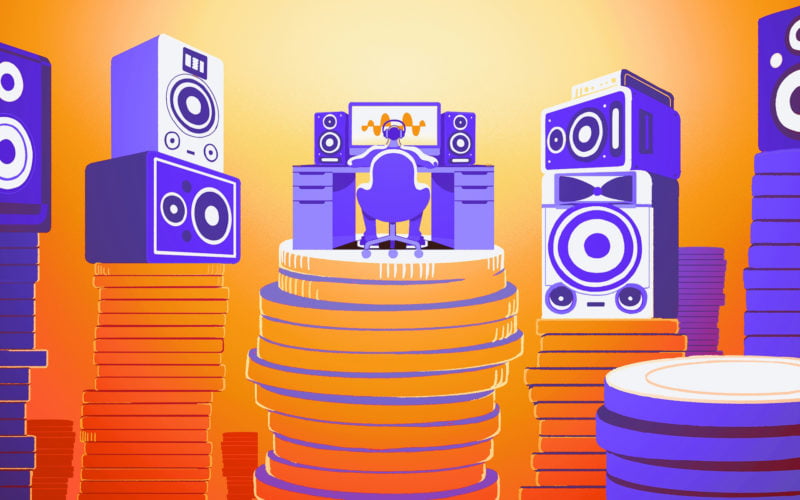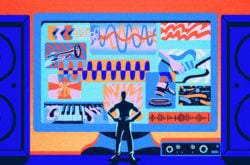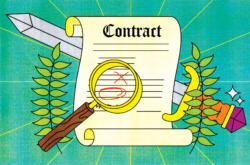Illustration: Franco Égalité
Those who’ve chosen music as their career are likely familiar with questions such as, “When are you going to get a real job?” and “Are you famous yet?”
On the other hand, you’ve probably also heard some call other artists ‘sellouts’ for achieving some sort of monetary success from their music. Why is music one of the few career paths where you’re expected to be either extremely poor or extremely rich? The irony of this dichotomy is that many artists believe that struggling financially is proof that they’re ‘real artists’ who are staying true to their art without going into more commercial ventures with ostensibly less artistic integrity. When you look at artists, beat makers, or producers who’ve ‘made it,’ there seems to always be a certain contingent of people who believe these artists had to compromise their art or integrity to make their living.
Often, this simply isn’t true.
Making money in the music industry can be challenging, but it’s not impossible and there are many artists and producers making a good living from their work without being extremely famous or making Billboard-charting hits. So, why is there such a negative stigma around making money in the music industry?
The history of making a living in music
If we look at the history of western music, many famous composers had wealthy patrons who commissioned their work. Those who didn’t would often work in churches or have some other type of steady avenue to support their music. That said, there were probably thousands of other amazing composers who we’ve never heard of because they didn’t have the financial backing to focus on their composition careers.
With the invention of the phonograph and the birth of the recording industry, however, there was suddenly a new way for musicians and composers to make money outside of live performance. With the development of recorded music came the record industry and record companies. Many record companies were able to launch artists to a level of stardom that was previously unheard of.
However, there’s also a dark history of record companies completely taking advantage of or extorting their artists for quick profits while also simultaneously owning the artists’ music and image. Prince famously rebelled against Warner Brothers to get out of his contract and buy back the masters to his own music. As the internet began to evolve, pirating, digital streaming, and the decline in physical record sales shook the music industry to its core. Social media followers became the new currency for emerging artists, and with platforms such as YouTube and SoundCloud, it became easier than ever to get your music to the world without a middleman.
This brings us to today, where we continue to ask the age-old question: How do you make meaningful money as a music creator?
The importance of setting up multiple streams of income
The answer is simple: you have to diversify your streams of income. The first thing every aspiring music producer must realize is that, despite their creative and artistic merit, they are in many ways a small business and must treat themselves as such. Many businesses fail because they’re unable to cover the cost of operations for their business and turn a profit. If you’re a music producer of any variety, your start-up costs don’t need to be more than $3,000. This is enough to get a decent laptop, DAW, audio interface, microphone, headphones, and speakers. You can upgrade your gear as you go, but once you make the initial investment, you shouldn’t have too many overhead costs. You don’t have employees to pay, materials to constantly restock, or a physical space (outside of your home) that you have to pay for to run your business.
The key to creating the economic infrastructure to pursue your dreams is knowing what opportunities exist and how to create a plan of consistent action to benefit from multiple streams of income. In this article, we’ll unpack some of the most common ways beat makers and producers can make money in today’s music industry.
1. Selling your beats online
One of the most common streams of income for aspiring producers is selling beats online. In fact, some make up to six figures a year just selling their beats. If you want to take the beats you’ve made to the online marketplace, there are a few things you have to understand: pricing, branding, and consistency.
Pricing
If you sell a beat to an artist, you’re usually also selling the exclusive rights to that beat. This means nobody else will be able to use it for their song. That said, beat-selling sites such as BeatStars and Airbit also allow producers to sell beats with a non-exclusive license. This means multiple people can buy the same beat, and you can limit the terms of use or what you deliver (.mp3 / tag, .mp3 and .wav, .wav file with stems, etc.).
If you want to sell beats online, then it’s good to think of a tiered system that provides different price points for people to buy your beats. For example, you could sell a basic license for your beat that just provides the .mp3 with your producer tag for $30. You could also offer the same beat for $50 with the .wav file and stems. You could then price the exclusive license at $250 – $300. The reason the exclusive license is significantly more expensive is because you can only sell it once. However, if you sell your beat at the $50 option ten times, you’ve already made more than the price of an exclusive license.
Branding
Now, if you think that you’ll instantly start selling beats if you upload a batch of them to one of these sites, you’re sadly mistaken. The key to selling beats is about building your brand and being consistent. Some producers use the ‘type beat’ method, uploading tracks to YouTube or their marketplace page that use an artist’s name to describe the style (ex. Drake-type beat, Lil Uzi-type beat, etc.). This method works well for uploading to YouTube because the artist names will improve your SEO when people are searching for beats in a particular style. Even if type beats aren’t your thing, it’s still important to include stylistic descriptors when naming or labeling your beat, so that the right people can discover it.
Another important aspect of your brand is your visual identity. If you look at most beat-selling sites, usually a beat will have some sort of artwork attached to it. This can range from a nice photo to a cartoon illustration. It can also be as simple as having a polished logo, and using your logo as the artwork for all of your beats.
Consistency
While the possibilities are endless, the most important thing is consistency. This goes for your visual identity as well as your upload schedule. If you’re able to make five beats a week, keep uploading the best three. If you can make ten beats a week, upload five every week. The more products you regularly have available, the more attractive you’ll be to potential customers.
2. Landing placements
Placements – when you contribute a beat in an album by a reputable artist – are the golden egg for producers. When you get a placement, your record has the potential to reach millions of people and propel your brand to a very high level. Depending on the artist, you might also have a chance to get an RIAA-certified Gold or Platinum record.
The only issue with placements is getting paid. Once you’re dealing with major record labels, you have to negotiate royalty splits and advances, which could take months after the song is completed. An average producer advance for a major label placement is anywhere between $2,000 – $10,000. In the past, these numbers were actually a lot higher, but with the decline in physical record sales, producer advances eventually became smaller and smaller. The good news is that once you get a major placement, you have a greater chance at getting another one.
So how do you get a major placement? There’s no one correct path to achieving this goal. One way is to build a relationship with an artist who you’re trying to work with, or with the producers who regularly work with that artist. This might be hard if you don’t know the artist or producers, but there’s often someone who may be easier to contact, like a manager or engineer who works with them. The best thing you can do as a producer is always being prepared. Have your beats ready, and if you get the contact of someone connected to an artist you want to work with, be ready to immediately offer some form of value.
You may be able to build a relationship with a producer by providing them a skill that’s unique to you. Recently, my friend A.J. Hall landed a few major placements by sending out drum breaks that he played and produced to a number of producers who he wanted to build relationships with. Not only did this work, but by the time he released the drum breaks publicly, he accumulated a nice list of credits to help promote his product.
Another route for getting a placement is to focus on building your brand and collaborating with smaller artists. Thanks to social media, you essentially have a media company right in the palm of your hand. If you commit to regularly posting content that showcases your work and aesthetic, there’s a chance that you’ll build an organic following that could lead to a big placement.
You can also try sending direct messages to artists on Twitter or Instagram. This may have a small chance of working, but in the case of the production duo Brasstracks, someone tweeted that they should produce for Chance the Rapper, so they sent him a message. They ended up connecting, and their resulting collaboration “No Problems” went on to win a GRAMMY.
3. Selling sample packs
There’s an ever-growing marketplace for royalty-free samples. If you’re a music producer who likes to do sound design or create custom samples, making a sample pack is a great way to earn some extra income and spread your name.
Why are sample packs a great way to make income? A simple answer is that it can become a very expensive and complex process to clear samples for a record you produced. Most beat makers who don’t have the backing of major-label lawyers try to avoid this altogether by using royalty-free samples. More and more producers are turning to Splice as well as buying sample packs from individual artists as a way to diversify their sound collection while avoiding legal risk.
If your sample pack is distributed by a digital marketplace such as Splice, then you’ll earn a royalty percentage. If you decide to sell your pack independently, while it can be harder to achieve a wide reach, you can name your price and make up to 100% of the profit. Learning how to design completely original sounds also makes you stand out as a producer, and will make you more attractive to others who are looking for collaborators.
4. Streaming your music
Streaming rates on Spotify and other platforms average at fractions of a penny per stream. This might sound dismal, but if you regularly release beat tapes or have collaborations with artists who can garner 500,000+ streams, then these fractions start to add up.
One of the keys to success in the streaming era is playlisting. If your music lands on a few popular playlists, then you’re guaranteed to achieve six-digit streaming numbers. While there’s no set formula for getting onto playlists, I would suggest having consistent output and focusing on honing your niche rather than making music to appeal to the largest crowd possible; there are more than enough popular playlists that span a wide range of popular and underground genres.
An alternative to streaming is selling your record online through a site like Bandcamp. This allows listeners to buy your music at full retail price, and you retain most of the profit. Bandcamp even allows fans to pay what they want, which means you could potentially get more than your asking price for your music.
GRAMMY-winning hip hop producer Knxwledge has released over 70 projects on Bandcamp since 2009. This huge back catalogue of work not only allows people to support him financially, but also makes his music more discoverable. Knxwledge landed his GRAMMY producing the song “Momma” on Kendrick Lamar’s hip hop opus To Pimp A Butterfly. The original track for “Momma” is actually called “So[rt],” and was included on one of Knxwledge Bandcamp releases, which Kendrick happened to hear at a photoshoot.
Whether it’s garnering streaming numbers or building a substantial discography on Bandcamp, the important thing to remember is that you have to finish and release music. Whether it’s beat tapes, collaborations, etc., you can’t access this stream of income by leaving all of those unreleased tracks on your computer.
5. Creating educational resources
Another avenue to explore is teaching or creating an online course. If you’re really good at breaking down music-related concepts, then teaching online could be something worth exploring. You can offer lessons via Skype or Zoom and build a small studio of students. Designing an online course is a little more complicated, but instead of taking on that endeavor alone, you could partner with another school or organization that wants to provide educational content to their students or audience.
Another thing to note is that many producers turn to YouTube to find the answers to their production questions. You can also use your expertise to create video content there that provides free educational value to the beat maker community, while also directing people to study with you privately. Many popular producers have also taken to Twitch to do live beat reviews, production breakdowns, etc. Twitch is great because it allows you to directly support the content creator by donating to them during their stream.
Working towards passive streams of income
In all honesty, there are many more streams of income you can pursue that aren’t mentioned here. No matter what streams you pursue, the biggest ideas to keep in mind are value and influence. What’s the value of your product, and what’s the influence of your brand? If people see value in the products you offer, they’ll support you. If companies see value in your brand, they’ll offer you sponsorships.
The goal should be to create enough quality content to the point where some of these streams of income become passive, meaning that someone is buying your beats, watching the ads placed on your YouTube videos, etc. while you’re relaxing or working on something else. The hardest part is putting in the initial work to set up these various streams. However, if you do this effectively, you’ll be able to not only make money, but make a living on your own terms without compromising your artistic integrity.
Explore royalty-free sounds from leading artists, producers, and sound designers:
September 23, 2020



